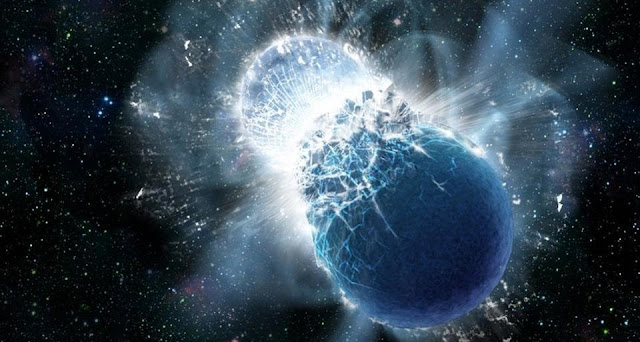The merging of two neutron stars and the creation of the heaviest elements
 |
Two merging
neutron stars, as illustrated here, do spiral in and emit gravitational waves,
but are much more difficult to detect than black holes. Credit: Dana Berry /
Skyworks Digital, Inc.
|
On August 17, 2017, LIGO and Virgo collaborations detected gravitational waves passing the Earth this was the fifth ever detected and it was named GW170817, and after about two seconds after the detection, ESA’s INTEGRAL telescope and NASA’s Fermi Gamma-ray Space Telescope observed a short gamma-ray burst.
The following night from the initial discovery, astronomers started their hunt to locate the source of the event. They found it in the lenticular galaxy NGC 4993, located about 130 million light-years from Earth in the constellation Hydra.
 |
First kilonova
observations by Hubble of GW170817 in the lenticular galaxy NGC 4993
|
Later, NASA’s and ESA’s space missions as well as dozens of ground-based observatories captured the fading glow of the blast’s expanding debris.
This is the first time, astronomers have observed the source of gravitational waves, created by the merger of two neutron stars, the event cause by the cataclysmic aftermaths of this kind of merger, was long-predicted, more than 30 years ago and it was called a kilonovae, which eject heavy elements such as gold and platinum into space.
 |
Virtual image
of an explosion caused by a kilonova created by the collision of two neutron
stars (European Southern Observatory)
|
This discovery also provides the strongest evidence yet that short-duration gamma-ray bursts are caused by mergers of neutron stars.
“This is extremely exciting science. Now, for the first time, we’ve seen light and gravitational waves produced by the same event. The detection of a gravitational-wave source’s light has revealed details of the event that cannot be determined from gravitational waves alone. The multiplier effect of study with many observatories is incredible.” said Dr. Paul Hertz, director of NASA’s Astrophysics Division at the agency’s headquarters in Washington.
The idea of neutron star mergers has been around for a long time, since there are many massive binary star systems with stars which should go supernova producing neutron stars, then in theory these mergers may happen, but it was no possible to observe it until now.
In fact, we have seen many binary pulsar systems, and we know those are neutron stars, just as black holes inspiral and merge, so, too, should neutron stars, but until now we weren’t able to see a merger, with the associated gravitational waves.
The gravitational wave signal indicated that, indeed, the neutron stars inspiraled at speeds up to a third the speed of light, collided-and-merged, and formed a black hole.
 |
An artist's
impression of two stars orbiting each other and progressing (from left to
right) to merger with resulting gravitational waves. Credit: NASA/CXC/GSFC/T.Strohmayer.
|
Interestingly, this cosmic event has shown us the making of heavy elements in front of us. We know that the lightest elements (hydrogen, helium, deuterium, lithium) were produced in the Big Bang nucleosynthesis.
Later, nuclear fusion taking place in stars converts hydrogen into helium, and for stars less massive than the Sun that is the only possible reaction, however in stars more massive than the Sun but up to 8 solar masses we see further reactions that convert helium to carbon and oxygen take place in successive stages of stellar evolution. This reaction chain continues to produce elements like silicon up to iron.
But elements higher than iron cannot be formed through fusion because of the supply energy needed for the reaction to take place. However, we see heavier elements in the Universe, so where they formed? The answers lie in supernovae. When the incredible explosions take place neutron capture reactions take place forming heavy elements, the other possibility was the neutron star merger.
 |
The gold we
find on the surface of Earth comes in veins and streak-like deposits. Credit: ETH-Zurich
|
For the first time, we now have visual evidence that the heaviest elements in the periodic table don't primarily arise from supernovae, but from neutron star collisions.
Duncan Brown of Syracuse University, an expert in gravitational wave astronomy and a member of the LIGO team said: "When you watch that radioactive decay, what you’re basically watching is space alchemy. It’s the universe creating gold and platinum."
According to Stefan Ballmer, who helped build the Advanced LIGO detectors, the amount of gold produced by this one collision rivals the mass of our Moon: "If you’re wondering how much the gold we saw being made is worth? About $10 octillion— $10,000,000,000,000,000,000,000,000,000—at today’s prices."
According to Edo Berger, “We’ve shown that the heaviest elements in the periodic table, whose origin was shrouded in mystery until today, are made in the mergers of neutron stars. Each merger can produce more than an Earth’s mass of precious metals like gold and platinum and many of the rare elements found in our cellphones.”
In addition, we've learned that these neutron stars formed some 11-12 billion years ago, and have been inching closer towards a merger ever since
Sources: Forbes, sci-news, Cornell, Wikipedia,









